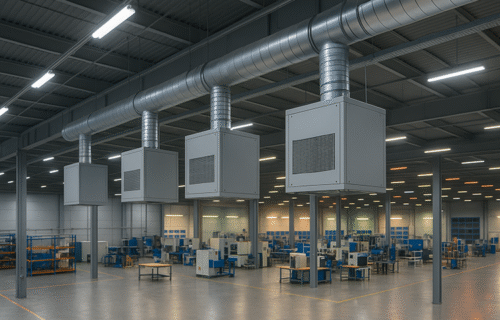Industrial developers are rethinking how they manage energy in production halls. Rising electricity costs, tighter ESG standards, and increasingly flexible manufacturing processes are pushing the sector to replace traditional, centralised HVAC systems with modular designs that can adapt to real-time conditions.
In older production buildings, a single large ventilation unit often ran continuously, consuming energy even when only a fraction of the space was in use. The new approach divides halls into smaller, independently operated zones, each managed by its own air-handling module. This design allows airflow and temperature to be regulated according to need, reducing power waste and operating costs.
According to Marcin Kosieniak, co-owner of PM Projekt, the shift represents more than a technical upgrade—it is a strategic response to new industrial realities. Smaller modular systems can be activated individually and expanded more easily when production grows. They also offer redundancy, meaning that if one module fails, others continue to operate without disrupting the entire process.
The evolution of these systems goes hand in hand with advances in automation. In many modern facilities, HVAC operations are now linked to building management platforms capable of exchanging data with production planning systems. This enables the ventilation to react dynamically to production schedules, machine activity, or staff shifts. A well-integrated system can, for instance, pre-condition work zones before a shift begins, ensuring a stable indoor environment as operations start.
Kosieniak emphasises that such functionality must be planned from the beginning. Retroactively adapting buildings for smart integration is often costly and inefficient. “The traditional ‘build first, adapt later’ model is no longer sustainable. Flexibility must be built into the system from the concept stage,” he says.
Research from industrial sites in Germany supports this new direction. Facilities using predictive control methods—where algorithms analyse historical data, weather forecasts, and upcoming production plans—have reported energy savings of up to one-third compared to conventional HVAC systems. The technology anticipates changing conditions hours or even days in advance and adjusts system performance automatically.
Similar pilot projects in Central Europe, including Poland and the Czech Republic, are beginning to test these adaptive systems, combining production management data with energy optimisation tools. Although still at an early stage, the results show clear potential for long-term efficiency gains and improved sustainability metrics.
As industrial real estate becomes more competitive, the energy performance of buildings is emerging as a defining factor in attracting tenants. Properties equipped with modular HVAC systems not only offer lower running costs but also align with the growing demand for sustainable operations. “In today’s market, production flexibility must extend to the building itself,” Kosieniak concludes. “Smart zoning is not a luxury feature—it’s fast becoming an essential part of industrial design.”
